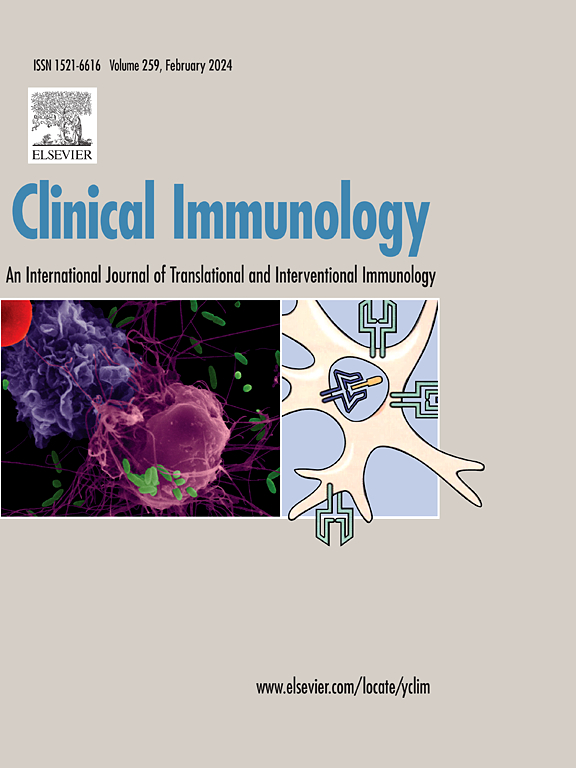1000 plex抗体阵列蛋白质组学筛选发现PGRPS, Haptoglobin, Serpin A4和fibrin原是儿童炎症性肠病的潜在粪便生物标志物
IF 4.5
3区 医学
Q2 IMMUNOLOGY
引用次数: 0
摘要
粪便样本易于获取且靠近患处,为炎性肠病(IBD)的非侵入性诊断方法的发展提供了巨大的潜力。使用治疗naïve对照组、克罗恩病(CD)和溃疡性结肠炎(UC)受试者(对照组= 24人,CD = 39人,UC = 10人)的粪便,对1000种粪便蛋白生物标志物进行基于抗体阵列的横断面蛋白质组学筛选。71种蛋白在IBD粪便中显著升高(p <;0.05;FC祝辞2),指出细胞因子信号、炎症反应和细胞外基质功能通路。在区分IBD和对照粪便方面,有几种蛋白优于粪钙保护蛋白,包括Haptoglobin、IL-1 R9、GDF-15、PGRPS、Serpin A4、insr、SSEA-1、纤维蛋白原、IGFBP-1和TGF-β RI/ALK-5。经ELISA验证,PGRPS (AUC = 0.96)、Haptoglobin (AUC = 0.91)、Serpin A4 (AUC = 0.73)是最具区别性的生物标志物。结合以往的横断面和纵向研究,本研究结果证实粪便PGRPS、Haptoglobin、Serpin A4和纤维蛋白原是UC和CD的潜在粪便生物标志物,值得进一步的前瞻性研究,以确定更可靠和准确的IBD非侵入性生物标志物。本文章由计算机程序翻译,如有差异,请以英文原文为准。
1000-plex antibody array proteomic screen uncovers PGRPS, Haptoglobin, Serpin A4 and Fibrinogen as potential stool biomarkers of pediatric inflammatory bowel disease
Easy to obtain and in close proximity to the affected areas, fecal samples offer significant potential for the advancement of non-invasive diagnostic methods for inflammatory bowel disease (IBD). A cross-sectional antibody array-based proteomic screen of 1000 fecal protein biomarkers was conducted using stool from treatment naïve control, Crohn's disease (CD), and ulcerative colitis (UC) subjects (control = 24, CD = 39, UC = 10). 71 proteins were significantly elevated in IBD stool (p < 0.05; FC > 2), pointing to cytokine signaling, inflammatory response and extra-cellular matrix functional pathways. Several proteins outperformed fecal calprotectin in distinguishing IBD from control stool, including Haptoglobin, IL-1 R9, GDF-15, PGRPS, Serpin A4, INSRR, SSEA-1, Fibrinogen, IGFBP-1, and TGF-β RI/ALK-5. Upon ELISA validation, PGRPS (AUC = 0.96), Haptoglobin (AUC = 0.91), Serpin A4 (AUC = 0.73), emerged as the most discriminatory biomarkers. Taken together with previous cross-sectional and longitudinal studies, the present findings authenticate stool PGRPS, Haptoglobin, Serpin A4 and fibrinogen as potential stool biomarkers of UC and CD, worthy of further prospective studies to identify more reliable and accurate non-invasive biomarkers for IBD.
求助全文
通过发布文献求助,成功后即可免费获取论文全文。
去求助
来源期刊

Clinical immunology
医学-免疫学
CiteScore
12.30
自引率
1.20%
发文量
212
审稿时长
34 days
期刊介绍:
Clinical Immunology publishes original research delving into the molecular and cellular foundations of immunological diseases. Additionally, the journal includes reviews covering timely subjects in basic immunology, along with case reports and letters to the editor.
 求助内容:
求助内容: 应助结果提醒方式:
应助结果提醒方式:


